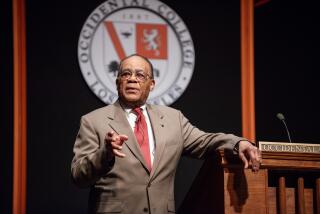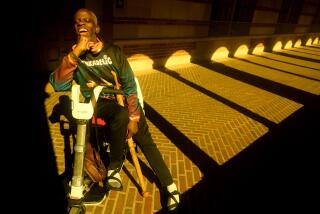Dr. Stanley van den Noort dies at 79; UC Irvine neurologist
Dr. Stanley van den Noort, the UC Irvine neurologist who championed the early treatment of multiple sclerosis patients and who, as dean of the university’s school of medicine, fought a 12-year losing battle to construct a major teaching hospital on campus, has died. He was 79.
Van den Noort died Wednesday at his home in Tustin of complications from a brain injury he suffered two years earlier, his family said.
Van den Noort built a large and successful MS practice at UC Irvine, drawing patients from throughout the country. He was also the first chief medical officer of the National Multiple Sclerosis Society and later headed its medical advisory board.
“Stan helped to build awareness, understanding and support for speeding us toward a world free of multiple sclerosis,” said Dr. John Richert, executive vice president of research and clinical programs at the society. “He will be missed by all that knew him.”
As dean of the medical school from 1973 to 1985, he oversaw an unprecedented era of growth at the institution, helping to establish it as a major research and treatment center. But he failed to achieve what he had hoped would be one of his biggest accomplishments, establishing a showcase teaching and research hospital on the campus that would match the prestige of the university’s sister schools in Los Angeles and San Diego.
His dream reached a partial fruition this year with the opening of UC Irvine’s Douglas Hospital, but that facility is miles away from campus in the city of Orange.
The California School of Medicine -- born in 1896 as the Pacific College of Osteopathy but forced toward conventional medicine by the American Medical Assn. -- had merged with UC Irvine in 1965. Most of its faculty practiced at nearby Hoag Memorial or the aging Orange County Medical Center in Orange.
When Van den Noort, already chair of the department of neurology, became dean, he began a concerted effort to establish a teaching hospital on campus. The state already had allocated funds for planning and the beginning of construction, but powerful local interests opposed it. The county wanted the university to take over Orange County Medical Center, which was a money- losing proposition for the county because of the large number of indigents being treated there. Many local physicians wanted a private hospital built on land owned by the Irvine Co. near UC Irvine, the proposed Irvine Medical Center. Whoever built a facility would have to receive approval from the state because of the perception that there were too many hospital beds already.
In 1976, the university acceded to the county and bought the 200-bed Orange County Medical Center for $1, renaming it UCI Medical Center.
After a long and bitter dispute between Van den Noort and his associates on one side and local interests on the other, then-Gov. Jerry Brown blocked the funds destined for UCI and shifted them toward construction of the UC San Francisco dental school. The university gave up its quest and, in 1985, new Chancellor Jack Peltason told Van den Noort that he would not be reappointed as dean.
Ironically, the state later precipitated construction of a new hospital, requiring massive earthquake-related retrofits to hospitals after the devastating 1994 Northridge earthquake. Those retrofits proved to be more expensive than construction of a new facility, and the Douglas Hospital was born. And the state paid for most of it.
Van den Noort was responsible for a number of other physical changes as well. At the start of his tenure, most medical center buildings were temporary facilities. He oversaw the construction of the first medical sciences building on the campus, as well as the creation of an on-campus facility, Gottschalk Medical Plaza, which housed clinics for diabetes, pain management, family medicine and weight management, among other things. He also established teaching and research collaborations with Long Beach Veterans Hospital and Long Beach Memorial Medical Center.
Stanley Van den Noort was born Sept. 8, 1930, in Lynn, Mass., the son of an immigrant from Holland. He originally wanted to be a historian, but his father persuaded him to study medicine because it paid better. He graduated from Dartmouth College in 1951 and earned his medical degree at Harvard Medical School in 1954. He did his residency in neurology at Boston City Hospital, where he first developed an interest in MS, then spent two years in the Navy.
After 10 years at Case Western Reserve University in Cleveland, he joined the newly created UC Irvine College of Medicine in 1970 as a professor and chair of neurology. His research was devoted to understanding the immune reactions that cause MS and to finding new ways to diagnose it early, when treatment can be more beneficial.
Together with James Roosevelt -- FDR’s son and a former congressman from California -- Van den Noort was influential in getting Congress to declare the 1990s as the Decade of the Brain to publicize the benefits of neurological research.
A compassionate doctor, Van den Noort often spent an hour or more with a patient rather than the designated 15 minutes. “I may not make a lot of money, but that’s the way I did it in 1954 and that’s how I’m doing it in 2004, “ he told Dartmouth’s alumni magazine. “Listen carefully to patients, and they will usually tell you their diagnosis.”
Van den Noort is survived by his wife of 55 years, the former June Byers LeClere; two sons, J. Eric of Irvine and Peter of Boston; three daughters, Susanne Rooney of Tustin, Kathy Corona of Camarillo and Betsy Spear of Westwood, Mass.; eight grandchildren; and a great-grandchild. Services are pending.
More to Read
Start your day right
Sign up for Essential California for news, features and recommendations from the L.A. Times and beyond in your inbox six days a week.
You may occasionally receive promotional content from the Los Angeles Times.






